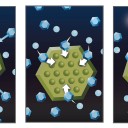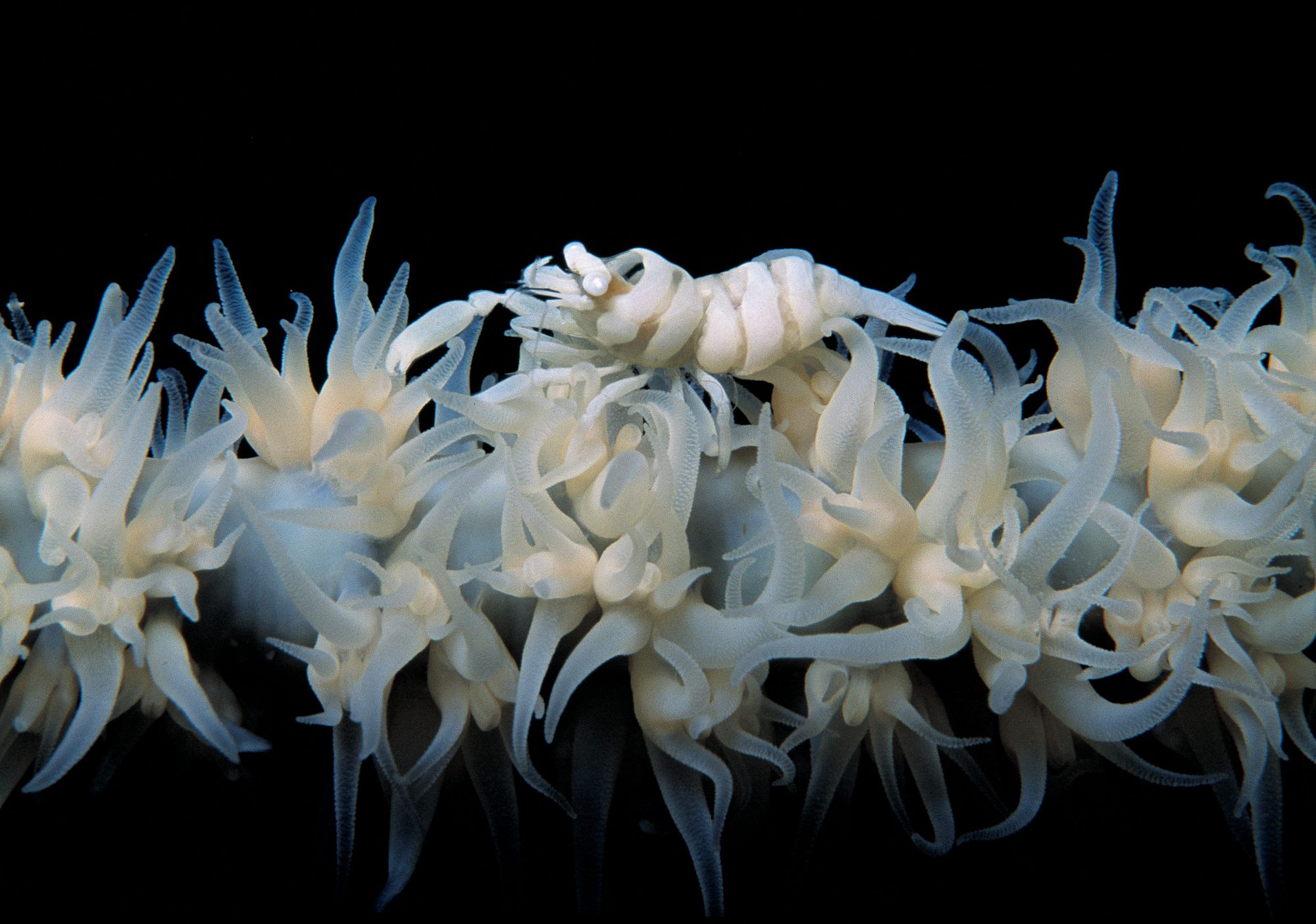
Invertebrate biodiversity
Taxa: a survey of marine invertebrate biodiversity
While we humans are vertebrates—creatures with backbones—and the animals with which we are most familiar (birds, cats, fish, dogs, cows, sheep, etc.) are also vertebrates, when it comes to the number of animal species in the world, the vertebrates are far outnumbered by invertebrates. All animals with backbones belong to just a single phylum Chordata—but there are some 33 other phyla of animals whose members all lack backbones. To confuse things a little, not even all chordates have backbones, however they all possess a structure that is thought to be a forerunner of a backbone—a notocord. The native lancelet Epigonichthys hectori—a 100 mm long bland fish-like creature—is an invertebrate chordate, as are the three New Zealand hagfish species, which also lack backbones.
Of the 35,112 known New Zealand species of Animalia, 33,582 species (95.6 per cent) are invertebrates. Of these, about 60 per cent are terrestrial, 33 per cent are marine, and 7 per cent live in freshwater. These proportions could change when the sea is better explored. The most species-rich phylum is Arthropoda, to which insects and spiders belong on land and crabs, barnacles and shrimps in the sea.
However, of the 34 phyla currently recognized, only nine have representatives on land. Yet examples from all but four phyla are found in the seas around New Zealand, and three of the absent phyla are also marine, though each is known from only one or two species. Hence the sea holds a much greater structural and genetic diversity of creatures than the land, and almost all this diversity is among the invertebrates.

Invertebrates perform critically important ecological roles and many are significant to humans as pests, food or other resources. The following “Cook’s tour” of marine phyla considers them in terms of their broad zoological relationships, and many of these relationships are controversial. Until a decade ago, relationships between groups of organisms were determined from anatomy and also from embryological similarities—the stages through which animals pass as they develop from egg to newborn. Now, analyses of RNA and DNA have been added to the mix and the nucleic acid results are not always in accord with traditional views.
This survey will start with the most primitive animals then move onto more complex groups.
The simplest animals are the sponges (Porifera)—porous creatures that act like living water filters. The sponge body consists of an array of microscopic chambers organized into tiny cups of tissue supported by tough collagen fibres and reinforced by microscopic splinters (spicules) of silica or calcium carbonate. Cells bearing whip-like hairs (cilia) cause water to flow through the sponge into the chambers where food particles are ingested, but sponges possess none of the specialized organs of higher animals. Sponges are widespread and ecologically important in the sea, sources of anticancer and other pharmaceutically useful compounds.
More complex creatures comprise the Ctenophora (comb jellies), delicate ocean predators of zooplankton and fish larvae, and Cnidaria (corals, anemones, and jellyfish). Both these phyla are basically radially symmetrical, like a flower or wheel. The gut (absent from sponges and placozoans, see below) has only one opening, which serves as both mouth and anus, and microscopically the body wall is formed from two layers of cells separated by jelly-like material.


Phylum Placozoa is known from a single named warm-water species (there may be others), a blob of cells a millimeter or two across that lives on shells and seaweed and feeds on protists. The structure of the junctions between its cells are the main feature that mark it as an animal at all. Though placozoans are not yet reported from New Zealand, a dedicated amateur naturalist may well be rewarded by finding them in Northland’s warmer waters. An array of microscope slides immersed in the lower intertidal for a month is just the sort of substratum they can adhere to.
Phylum Myxozoa comprises tiny, simple parasites with dubious affinities. Translated, the name means “slime animals” which says it all. They have been considered protozoans (hence not animals) at times or parasitic cnidarians, but currently are in their own animal phylum. They resemble tiny blobs of tissue and many have a two-host life cycle involving a fish and either an annelid worm or a bryozoan. One species, Myxobolus cerebralis causes whirling disease in trout.
All other animals are fundamentally bilaterally symmetrical and the body wall is formed from three layers of tissue. The Bilateria are in turn divided into two major branches of the animal kingdom (Protostomia and Deuterostomia), based on how the mouth and anus form in the embryo. Protostomes (“mouth forms first”) and deuterostomes (“mouth forms second”) have fundamentally different types of larvae and the basic arrangement of the nervous system also differs. Protostomes are further subdivided into two groups—Lophotrochozoa (mostly worm-like and shelled organisms) and Ecdysozoa (moulting animals).
Protostomia-Lophotrochozoa
This grouping has been arrived at by studies of gene sequences, but the name is derived from one given to animals that feed using a tentaculate structure termed a lophophore, with those that have a larval stage called a trochophore. Most phyla in this grouping have either one or other of these features.
The flatworms, phylum Platyhelminthes, are unsegmented worms that can be either free-living or parasitic. They have no circulatory or respiratory systems, and parasitic species may even lack a gut. Waste, nutrients and oxygen simply diffuse through the body wall. Platyhelminths have a simple nervous system, various sensory organs and can reproduce either sexually or asexually. Flukes and tapeworms are examples of parasitic platyhelminths.
Rhombozoa, or Dicyemida, is a phylum of tiny parasites that live in the kidneys of cephalopods (octopus, squid and cuttlefish)—a very specialized existence. Adult dicyemids range in length from 0.1–9.0 mm, and they have embraced the ever-popular worm form. Dicyemids display eutely, in which each adult individual of a given species has the same number of cells, making cell number a useful identifying character—in the most unlikely event you can count them. Both asexual and sexual forms exist. The former predominate in juvenile and immature hosts, and the latter in mature hosts. While not strictly host specific, most dicyemids are only found in a few closely related host species.
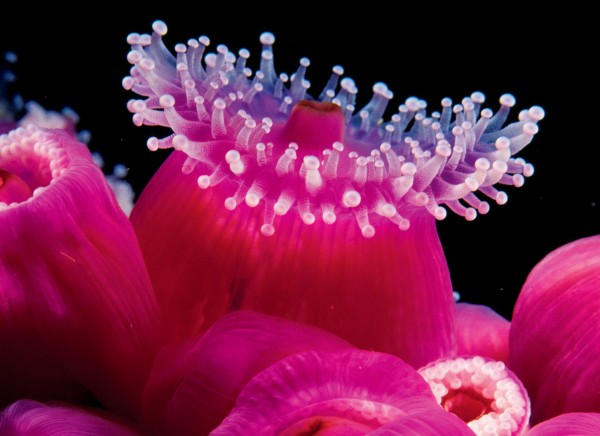
Gastrotricha (the name translates as “hairy belly”) are 0.1–4 mm sized worm-shaped organisms that typically live between the grains of sand on beaches and attach to vegetation in freshwater. Externally, the body has a cuticle (like an insect) which bears scales, spines and bristles. Internally, gastrotrichs have a gut (they feed on bacteria, fungi and protozoans), and nervous and reproductive systems.
Phylum Gnathifera is a recently created super-group that includes several groups previously considered separate phyla, including rotifers, gnathostomulida, and acanthocephala.
Gnatha means “jaws” and the first two groups, together with the linking Micrognathozoa, are all minute aquatic animals bearing distinctive hard jaws in the pharynx. Acanthocephala are parasites of vertebrate intestines, and have a much reduced digestive system and pharynx, but other characters suggest affinities with rotifers. Rotifera are sub-millimetre animals that live in water or damp environments. Despite their minute size, they possess a body cavity containing regular organs and many have a crown of large cilia surrounding the mouth that directs in food particles (giving rise to an early name, “wheel animalcules”, bestowed by their discoverer, the Dutch microscopist Antonie van Leeuwenhoek, in 1703). Their jaw-like structures in the pharynx are termed trophi. The body is clad in a semi-flexible cuticle. Some attach by a stalk and foot to a substratum while others swim freely.
Phylum Cycliophora (pandoras) was created in 1995 to hold one newly discovered species 0.3 mm long, found attached to bristles around the mouth of the Norway lobster. This creature is goblet-shaped and attaches by a basal sucker at the end of its short stem. The gut is U-shaped so the anus is near the mouth, which is fringed by cilia. Reproduction and the life history are extraordinarily complicated. Pandoras have not yet been found in New Zealand.
Brachiopoda (lamp shells), superficially resemble bivalve molluscs in that they have two shells, but their anatomy is quite different. They feed by filtering plankton out of seawater using a lophophore, a structure that may be horseshoe shaped or longer and coiled and is covered with hollow tentacles that are themselves ciliated. Most brachiopods attach to the substratum with a stalk so, apart from some mud-dwelling burrowers, move. They are a very ancient group and there are far more fossil species than living.
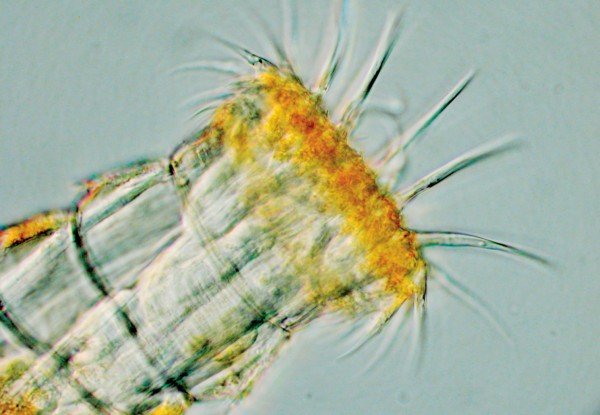
Horseshoe worms or Phoronida is a phylum consisting of 12 species in two genera—one of the small phyla. The body is worm-like and one end is buried in sand while the other feeds with a fan-like lophophore. The gut is U-shaped and the anus is not far from the mouth. Because the body is soft, there is no fossil record for phoronids which are entirely marine.
Bryozoa (see NZ Geographic 61) are colonial aquatic organisms in which each individual is called a zooid, many of which secrete calcareous skeletons giving rise to one of their common names, lace corals. Bryozoan skeletons are a major component of limestone. Individual zooids in a colony may specialize in different tasks such as feeding (for which they use a lophophore), reproduction or defence. Bryozoans are encrusting organisms (like sponges and corals) growing on rocks, seaweeds, shells, and sometimes fouling water intakes and boat hulls.
Entoprocta, sometimes known as goblet worms, are small (0.5–5 mm) aquatic creatures that usually attach to a substratum and can be either solitary or colonial. They are filter feeders, filtering plankton with a tentacled crown, and have a U-shaped gut with the anus situated inside the ring of lophophore tentacles. They have no hard parts so are not preserved in the fossil record.
Phyum Nemertea (proboscis or ribbon worms) is another little-known group, but its 900 species include terrestrial, freshwater and marine representatives. Externally, these worms are smooth, and although some species reach 50 or more metres in length, they are generally only a few millimeters wide or less. They have a gut, well developed nervous system, reproduce either sexually or asexually, and also have blood vessels. Most are predators and have a long proboscis that can be pushed out to grab prey. Sometime this proboscis is as long as the worm—though not in the 50 m specimens.
Sipuncula, a phylum of marine worms, are sometimes known as peanut worms because many of them are plumpish, smooth and brown when contracted. They have a gut with an anus at about shoulder level—and a powerful eversible proboscis that they thrust out and enlarge to anchor in the sand. The body is then dragged up to it. Of course, this proboscis is also used for the more customary task of feeding.
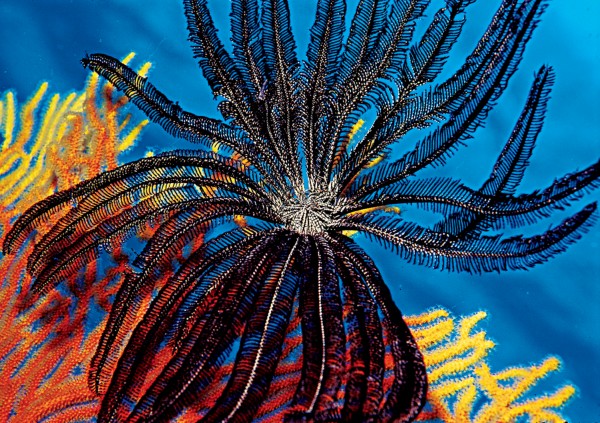
The group with the largest number of species (about 130,000 named and living) on this branch of the taxonomic tree is the Mollusca (chitons, snails, clams, tusk shells, squids and octopods, plus the poorly known aplacophora and monoplacophora). Several New Zealand species constitute major commercial and recreational fisheries (paua, mussels, scallops, oysters, toheroa, cockle, pipi and some squid). Molluscs are very difficult to characterise as a group. Most have shells but not all, most have a head and muscular foot, most have a sheet of tissue that lines the shell termed the mantle, and this forms a sac (the mantle cavity) in which organs like the gills lie. Even groups like octopods—which lack a shell—retain a mantle and mantle cavity. The very largest swimming invertebrates—squid weighing hundreds of kilos—are molluscs.
Annelida is a phylum with a great many members including familiar garden worms, leeches and a huge variety of marine species. Segments, shown on the surface by rings that also extend into the body proper to at least some extent, characterize this phylum. These are quite advanced animals with nephridia (kidneys) in each segment, and well developed circulatory, nervous, sensory, reproductive and digestive systems. Some species have gills and there is a variety of feeding patterns from predation to filter feeding.
Echiura or spoon worms are sometimes classified as annelids and sometimes given their own phylum. Unlike annelids, they lack rings, but their larvae are very similar. Locally, they are large pink fleshy worms with an extensible proboscis that live in deep U-shaped burrows in sand and mud.
Orthonectida is an enigmatic phylum containing about 20 species of tiny wormlike parasites of marine invertebrates. It is uncertain whether they belong among the lophotrochozoans. They appear to be very primitive multicellular organisms, lacking both gut and nervous system, and physically resembling multicellular protozoans. However, parasitism often allows great simplification of structure and so these deficiencies may be misleading. A worm-like cuticle and genetic analyses suggest affinities with more advanced groups than protozoans.

Chaetognatha, arrow worms, range from 1 to 100 mm long. They possess a head, trunk, tail, two side fins, gut, nerves and reproductive system, but lack respiratory, circulatory and excretory systems. They are voracious predators and feed on small marine organisms such as fish larvae and copepods which occur in plankton where arrow worms are also often abundant. Some species poison their prey with a toxin produced by bacteria that live in their head. The mouth has chitinous teeth and grappling hooks to seize prey. How arrow worms are related to other groups remains unresolved.
Many animals—such as insects—are encased in a firm “skin” or cuticle that cannot stretch as the animal grows, but must be replaced with a larger size. Such creatures undergo ecdysis—a process by which the old cuticle splits and is shed to be replaced by a new cuticle that hardens once exposed to air. Ecdysozoa is the name given to the group of phyla whose members undergo ecdysis (moulting), a mode of growing which is thought to have only arisen once in the animal kingdom. Because most animals—including vertebrates—lack the biochemical pathways for ecdysis and forming new cuticle, chemicals that interfere with this process kill developing insects and lice very specifically with few side effects on other animals. Indeed, these chemicals (termed insect growth regulators) are now widely used in agriculture and horticulture and are not even toxic to adult insects that are no longer undergoing ecdysis.
Protostomia-Ecdysozoa
Phylum Arthropoda contains more described species than all other animal phyla combined. On land, its representatives include insects, spiders, mites, lice, centipedes, scorpions, slaters and silverfish. In the sea, there are crayfish, shrimps, krill, crabs, barnacles, pycnogonids, copepods, sea lice, sand hoppers and many more.
In arthropods, the body is divided into segments and the segments are often fused into head, thorax and abdomen. Each segment typically carries a pair of jointed appendages such as legs, antennae, nippers (chelae) or mouthparts. The cuticle forms a hard exoskeleton to which muscles attach. Arthropods possess a good range of organs and advanced sensory systems, typically lay eggs, and during development undergo metamorphosis (e.g. from crawling larva to flying adult, or swimming larva to sessile adult in the case of barnacles).
Onychophora (peripatus, velvet worms) is the only phylum with no aquatic members. It has been discussed in NZ Geographic 46, so will not be further described here.


Tardigrada or water bears grow to no more than a millimeter in size and typically have a chubby cylindrical body with eight heavy-clawed limbs. The limbs are not jointed, unlike those of arthropods. Beside the mouth, they carry two sharp little swords for penetrating the cells of organisms they feed on. Tardigrades either live in aquatic environments or are surrounded by a film of water in a moist terrestrial setting. That said, they can dry out and enter a state of suspended animation in which they can survive very adverse conditions for years or decades.
Phylum Nematoda are smooth unsegmented worms that are little-known by the public but a major group by any method of accounting. Most species are minute, but the largest is a 13 m whale parasite. They are abundant in every environment from the deep ocean floor to ice and hot springs and they can go into suspended animation (aestivation) like tardigrades and rotifers. Many are parasites of plants and animals. (Drenches for farm animals and pets are primarily aimed at killing parasitic nematodes.) Nematodes have a tough, flexible cuticle that is shed by ecdysis during growth, and few external features to enable easy identification. Although only about 15,000 species have been described, it is thought nematodes may exceed arthropods in number of actual species. A much-studied nematode Caenorhabditis elegans was described in NZ Geographic 65 (2003), p18.
Phylum Nematomorpha contains long, very thin worms—hence their name horsehair worms. Actually, it is only the brief adult stage that is a thin worm, a stage that doesn’t feed and has only the remains of a gut, but a stage that lays lots of eggs in water. Eggs hatch into larvae which enter aquatic animals—and remain in arrested development for up to a year until they find their way into a suitable arthropod host (often a cricket or weta) or, for marine species, a crab or shrimp. In the host they develop into the long worm that exits the host when it is in or near water. They then ecdyse once, mate, lay eggs and die.
The members of the small phylum Priapulida (it contains fewer than 20 species) are all marine bottom-dwelling worms, ranging in size from 1 to 400 mm. The body has rings but is not segmented internally, and is divided into an anterior (head) part termed the prosoma and a posterior trunk into which the prosoma can be withdrawn. There is a mouth at the end of the prosoma, and an anus at the end of the trunk. Five spines (termed scalids) surround the mouth and there may be rows of more small scalids on the prosoma. The sexes are separate and eggs and sperm are shed into the sea where fertilization takes place. Food is thought to be other worms.
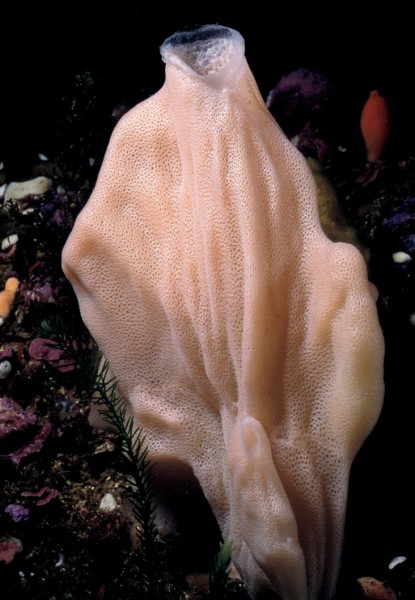
Kinorhyncha are another obscure phylum containing some 150 species of sub-millimetre marine worms. The body is divided into 13 segments and each bears spines but no limbs. In moving, the head spines are flattened, the head is thrust forward, and the spines splayed to form an anchor. The body is then hauled up to the head. They have a well-developed gut with posterior anus and the sexes are separate. They feed on bacteria and micro algae found in the soft sediments in which they live.
The first members of the phylum Loricifera were only discovered in the 1980s, and they are a group of minute (0.5 mm) marine organisms that live among grains of coarse sand and gravel on the seafloor and adhere to individual particles. Creatures of this size that live in sand and mud on the seafloor are given the general name meiofauna. Loriciferans possess a small head, neck and thorax that can retract into the bulbous trunk, but the body is not segmented. The head may carry spines but the group’s most characteristic feature is a girdle of prominent movable spines around the thorax. The trunk or lorica is protected by a series of armoured plates. For their size, they possess a large brain, they have a mouth at one end of the body and an anus at the other, and the sexes are separate.
Deuterostomia
Starfish, sand dollars, sea lilies, sea urchins and sea cucumbers are all members of the great and fascinating phylum Echinodermata (meaning spiny skinned). It has about 7000 living members—all of which are marine—and twice as many are known as fossils. Echinoderms have several distinctive features. The adults are all based on a distinctive fivefold radial symmetry, they possess a water vascular system and exoskeleton made from calcium carbonate spines and plates. In sea urchins and sand dollars these plates interlock to form a solid “shell”, but in starfish they are less continuous and in sea cucumbers microscopic. The water vascular system uses water pressure to power the hundreds of small tube feet that echinoderms use to move and adhere with, and also the feeding structures and gills. The nervous system is poorly developed. A particular curiosity is that the radially symmetrical adults develop from bilaterally symmetrical larvae.
Phylum Xenoturbellida contains only a single species found in the Baltic Sea and Scotland, a creature again described as wormlike and living in soft mud. It is neither parasitic nor minute (up to 4 cm) but is certainly enigmatic. It consists of a bag of tissue with a mouth but no anus, a diffuse net of nerves, and no organs except a statocyst—a kind of gravity detector used for orientation.
Most members of phylum Hemichordata are soft marine worms, however they have some of the features of chordates. For instance, they possess gill slits opening into the pharynx (as do fish). In most invertebrates the main nerves are ventral. All the 200 species of hemichordate are marine and most are 10–30 cm long. Graptolites, a long-extinct group of important fossils, are now also considered to be hemichordates.

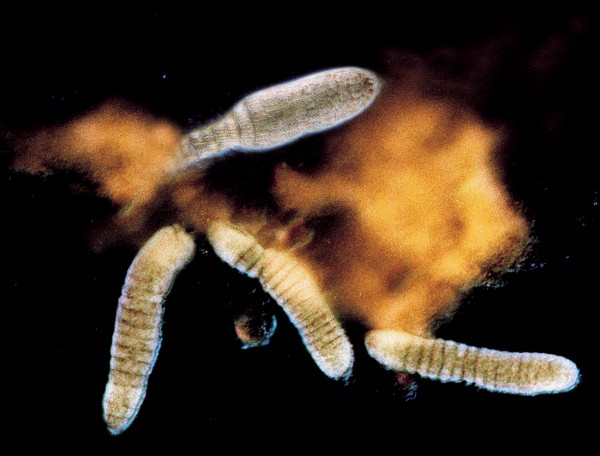
Tunicata (sea squirts, salps, and appendicularians) have distinctive outer coverings or tunics, made of a type of cellulose. Sea squirts are familiar as intertidal organisms—typically firm bladders the size of a prune with two prominent openings attached to the sides of rocks. Squeeze and water will spurt out. They feed by filtering plankton from seawater. Although sea squirts bear no resemblance to vertebrates, they are considered to be ancestral to chordates. Tunicate larvae resemble miniature tadpoles and possess a notocord—a forerunner of the chordate spine—and dorsal nerve cord. A larva finds a suitable place to settle and then quickly metamorphoses into the sedentary adult form.
Chordata are characterised by the presence of a notocord during development and a single, hollow dorsal nerve cord. In vertebrates, the notocord is largely replaced with a backbone containing the spinal cord. The main vertebrate species found in the seas around New Zealand are fish, cetaceans, seals, and seabirds—but we are not interested in them because this is a survey of invertebrate biodiversity.
While this brief survey may seem bewildering, it only scrapes the surface of diversity among marine invertebrates. Most phyla contain multiple classes, orders and families and these can all differ dramatically from one another. Many species go through complex life histories, where one phase bears little resemblance to what follows. Ashore, we can watch a caterpillar with 30 legs become a cocoon with no legs and then a moth with six legs, but this is more difficult to see in the ocean where there is still a vast amount of startling biology awaiting discovery.













